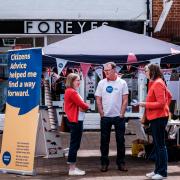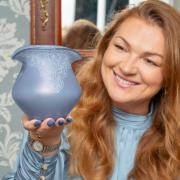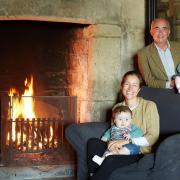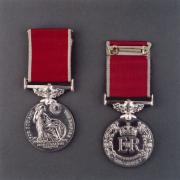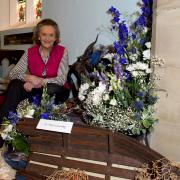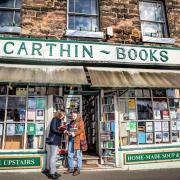At Wirksworth’s historic Haarlem Mill, something very special is happening. Viv Micklefield pays this famous building a visit and learns about its past, the creative industries now flourishing there and the impact this has on the town.
On the face of it, the Derbyshire Dales town of Wirksworth has successfully reinvented itself several times over; a pervading fighting spirit, backed by initiative and hard work, carrying it through the economic peaks and troughs following the rise and fall of local mining, quarrying and milling industries.
However, these days, as dependence on traditional trades has receded, the drive for profit has been challenged.
Instead, there’s a vision for an altogether more altruistic environment that favours mutual care, exchange and collaboration between those involved in the burgeoning creative industries.
A major driver is the Haarlem Project, the umbrella for two not-for-profit community interest groups: Haarlem Studios and Haarlem Artspace.

With a cultural manifesto which advocates that rural art no longer has to mean prosaic art, a visit to historic Haarlem Mill reveals the catalyst behind this movement.
‘There’s a strong independent spirit here in Wirksworth,’ says co-director Paul Carr. ‘If you walk down the High Street there are no empty shops. I’ve been here since 1997 living on North End, and on just this one street we’ve got a film-maker, a sculptor, and a printmaker. With over 150 practising artists, it’s a fabulous town in which to develop your creative potential.’
‘Wirksworth has long attracted artists,’ agrees co-director Sarah Armstrong, herself a studio holder at the Mill. ‘The Puzzle Gardens, in the old part of town, were condemned in the late 1970s and 1980s but when a preservation order was imposed, a lot of artists moved in.
‘Haarlem Studios came about in 2016 because some of the local artists were still commuting back into the nearby cities for studio space. We’ve had people moving-up from London too as they like the artistic buzz, which you sometimes don’t get within a rural community.’
As Paul acknowledges, the Grade II* listed Mill has an impressive heritage. Built in 1777 by pioneering industrialist Richard Arkwright as the first steam powered cotton mill in the world, it became famous for producing Whitehall’s red tape.
The irony of this once ubiquitous symbol of bureaucracy now hosting such a boundary pushing organisation is not lost on him. Nor on Sarah, who also programmes the Haarlem Artspace Gallery for studio holders’ work within the Red Lion Hotel, the town’s former Assembly Rooms.
Reflecting on the mix of professional creatives and hobbyists currently occupying the 28 studios, which are offered at cost, she believes it’s a healthy combination, with the permanent gallery, an added benefit.
‘It’s good because the designer-makers have a shop for their work; our studio holders are offered free exhibitions, sometime this might be two artists, at other times more,’ she reveals. ‘This means we’ve been able to give a platform for all levels to showcase their work.’

One artist hoping to introduce her work to an even wider audience is free-blown glass lighting designer and returning ceramicist Esther Patterson.
Being able to fire her new range of slip cast and hand-turned elements within a neighbouring studio holder’s kiln is a bonus, so too working alongside fellow artists beyond the Mill’s walls.
‘Having the studio keeps my brain going creatively,’ says Esther. ‘Despite already running another business, I needed to keep exploring and really appreciate being part of a creative hub.
‘During a residency in Shining Cliff Woods we shared ideas to develop our practice. This was a great experience and some of the outcomes from Out of the Woods will be previewed in the Gallery.’
Also on the ground floor, where studio spaces are defined by simple timber-clad walls, the eclectic blend of creatives includes illustrator and designer Charlie Swain. It’s a facility that’s shared with his wife, who’s an artist.
‘We’ve been here a couple of months and use this space at different times, which works very well for us,’ observes Charlie.
Charlie has returned to his Derbyshire roots, having lived and worked in both the USA and London, adding: ‘It’s definitely providing a service in the local area.’

Meanwhile, a few steps along a corridor, is Renée Brailsford, an award-winning garden designer and plantswoman with a love for the local landscape. Renée’s another who embraces Haarlem’s collaborative spirit.
‘Having previously worked from home, I’ve had a Mill studio for four years,’ she says. ‘For me, it’s nice to have other creatives around. Plus, I’ve been able to have a video made and a logo designed for my business by people who are based here.’
Surrounded by the tools of the trade used to create unique hand-formed jewellery from recycled precious metals, Amanda Graham, who’s also made the switch from home-working, agrees.
‘It’s given me so much extra space in which to work; after arriving in 2023, I definitely plan to stay.’
And, as Amanda points out, many of her designs express a strong connection with the rural heritage outside.
‘I often include vitreous enamel into my work which reflects the influence of my environment; some of the disused quarries are hundreds of years old.’
Ascending the stairs to upper storeys – the Mill’s first floor is let to another tenant of Gordon Wardman who owns the Mill and oversaw its latest restoration – there’s an altogether more open feel. This, Paul explains, allows for greater adaptability as studio holders’ needs change.

Sarah Ogden, a floral artist who’s hard at work putting the finishing touches to one of the stunning dried and preserved wedding arrangements she specialises in, relishes the surroundings.
‘It’s amazing being here within a creative community,’ says Sarah. ‘This is a lovely building with so much character.’
With the third floor open to the original roof beams, this lofty light-filled space accommodates the multitude of contemporary mixed media and visual artists who work here.
And, soon, it will not only be the Gallery that will introduce studio holders’ work to prospective customers. Paul believes Wirksworth still offers un-tapped possibilities.
‘For me, the High Street needs to change: the successful ones are moving away from service towards experiential, and Wirksworth now has a lot more tourists,’ he argues.
‘Before I got involved at Haarlem Mill, I wanted to open up a shop in town that celebrated hand-crafted products. This was put on the back burner when I started here in 2022, but then we had the great opportunity of opening a pop-up on St John Street to test the co-operative working model.
‘This was originally for three months but actually lasted six. The artists involved paid to have their work shown, keeping whatever they sold in return for manning the shop. It was great way for each of them to test their price point but, importantly, it brought them together. Even though you’re working across three floors everyone has different hours and might only pass on the stairs.
‘Having had over 5,000 visitors to the pop-up, I’ve had the confidence to revisit my original plan and to bolt-on Haarlem Artspace.
‘This will give the Haarlem artists a permanent shop window and the rest of the town an insight into what goes on down here. There are also three rooms at the back of the new premises, which will become studios and are already taken.
‘The unit we’ve now taken over was previously Top Kens, which had been in the town for over 50 years, in itself almost an historical artefact. Following a Christmas pop-up, this will be closed in January and February ready for the main re-fit and re-opening in spring.’
With the right-hand side of the building given over to a curated collection of artisan makes there will, says Paul, be plenty to interest shoppers.
‘We’ll have knives, plates, ceramics etcetera, including, Wirksworth’s own Milly Melbourne. Plus, biodynamic and organic wine, as well as English cheeses for sale. And there will be a bookshop.’
As a nod to Haarlem’s heritage and its symbiotic relationship with the town, the new venture’s window display will feature a contemporary art piece made by studio holder Jo Heron, from a bag of the original tapes manufactured at the Mill.
And Sarah is just as excited about this latest addition to the cultural landscape.
‘The Artspace Gallery is just across the road, so this will work really well,’ she concludes.
‘The Gallery itself will be closed until the beginning of March allowing me to programme the following six months and, on reopening, we’ll have the extra attraction of a small café area.’
With the future prospect of a new sculpture trail, stretching from Haarlem Mill up to the National Stone Centre, the spark has been well and truly lit on Wirksworth’s latest transformation.




